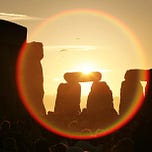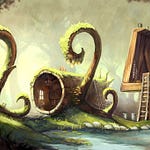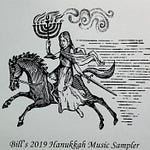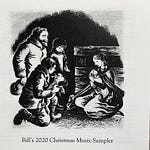Nominally this 2021 collection had a Winter Solstice theme but I took many digressions from that, including two days about American Thanksgiving and four days of music about Hanukkah.
All of today’s songs, and detailed information about them (with pictures), are already available online in my blog/archive. Rather than repeat most of that information here, my music notes will be relatively brief and include a direct link to that day’s entry in the archive.
Playlist
Bonjour l’Hiver Charlotte Diamond 2:00
The Halsway Carol Siobhán Kennedy 3:25
'Namgis-Mowachaht Entrance Song First Nation members 2:10
The Enemy Came as a Wolf Nellie Youpee and Ruth Short Bull 2:12
La Guillonné l'on vous demande Gabrielle Bouthillier with Strada 1:55
Song of Solstice John Roberts, Tony Barrand with the OCEAN Orchestra 3:20
Music notes
Bonjour l’Hiver is sung here by children’s performer Charlotte Diamond who wrote it along with her accompanist at the time, Paul Gilitz. It comes from her 2005 album by the same name, which includes lyrics and instrumental versions of every song so that kids can karaoke them. Actually, there are French and English versions of each song on separate albums. The lyrics for the English version of this one are:
Hello winter, how are you today?
I'm so glad that you have come my way.
Hello winter, say you're looking fine.
Won't you have a cup of tea and join these friends of mine.With your icicles on bicycles riding in the snow
Snowflakes falling tickling my nose
Sleigh rides let's go skating round and round
I'm so glad that you have come to visit in our town.
More information, another children’s winter song, and a reminiscence essay about my winters as a young child are in my Nov 29, 2021 posting.
The Halsway Carol The melody for this song is known as the Halsway Schottische when it is in tune form, and actually it was the tune that came first. A schottische is a partnered country dance that originated in Bohemia and was very popular in Victorian era ballrooms. This one was written by hurdy-gurdy player Nigel Eaton in October 2011. Soon after he wrote it, a friend who was organizing a hurdy-gurdy weekend camp at Halsway Manor invited him to teach it in a workshop there. I don’t know if Nigel gave the tune this name, or if that is just what the folks at the camp began to call it.
One of the attendees at the camp was another hurdy-gurdy player, Iain Frisk. He was inspired to make some adaptations and write these seasonal lyrics for it. Thus, The Halsway Carol was born. This version of his song is by Siobhán Kennedy and was recorded on her 2014 album Séid. Her accompanist is Jens Kommnick. I got it from a posting on YouTube (where the video has beautiful photos of Watlington Hill around midwinter that same year. Here are the lyrics:
“Lo for the tiding of the Long Night Moon
Let the sunrise call about the morning soon
Short is the biding of the fading light
Sing for the coming of the longest nightNorth wind tell us what we need to know
When the stars are shining on the midnight snow
All of the branches will be turned to white
Sing for the coming of the longest nightA winter day, the summer grass turned hay
Frost in the field ‘til the dawn of May
A summer’s light never shone as great or as bright
So dance in the shadows of a winter’s nightLo for the tiding of the Long Night Moon
May the harvest last until the springtime bloom
Home is our comfort at the winter’s height
Sing for the coming of the longest nightAll of the colours of the sunrise sky
Shine a light upon us, as the day goes by
Sunsetting shadows fading out of sight
Sing for the coming of the longest nightA winter day, the summer grass turned hay
Frost in the field ‘til the dawn of May
A summer’s light never shone as great or as bright
So dance in the shadows of a winter’s night
There is more information about this tune and song in my Dec 8, 2021 posting.
'Namgis-Mowachaht Entrance Song For the native people of North America’s Pacific Northwest, winter was the time for potlatches, their most important community-building ceremonies through which people would lay claim to their hereditary titles and rights. Entrance songs would be sung by visitors arriving at the host’s longhouse in their giant cedar travelling canoes. Here is archival footage of a 1914 re-enactment of such an entrance, filmed by Edward S. Curtis.
This is a traditional song that the 'Namgis, a sub-group of the Kwakwa̱ka̱ʼwakw language-speaking people who lived on the northern tip of Vancouver Island, share with the Mowachaht-speaking Nuu chah nulth people who live on north-west side of the Island. In the coastal native tradition, the rights to sing certain songs are owned by individuals or communities. Sharing the same entrance song is a meaningful statement in intertribal diplomacy.
This recording was made in 2002 by ‘Namgis singers for the CD album Laxwe'gila – Gaining Strength, recorded in support of a five-day gathering by that name held in Alert Bay where the ‘Namgis now live. Click here for more information about this song, to hear another ‘Namgis paddling song, and to read a reminiscence essay about the privilege I had of attending Hereditary Chief Chester Lawson’s potlatch in the remote community of Bella Bella on an island off BC’s mid-coast.
The Enemy Came as a Wolf This is a traditional celebration song of the Mandan and Hidatsa people. They were peaceful, hospitable tribes who spoke different Sioux dialects but dwelt very close to each other living an agrarian lifestyle on the upper reaches of the Missouri River.
This song was collected from Scattered Corn in 1912 by Frances Densmore. She was one of the first ethnomusicologists to make field recordings on Edison wax cylinders. It, or songs like it, were heard by the Lewis and Clark Corps of Discovery when they wintered over adjacent to a Mandan settlement in 1804-05. It is sung here by Nellie Youpee and Ruth Short Bull, recorded in 1999 for the album People of the Willows.
The weather was particularly harsh that year but the Mandan Chief Sheheke had assured the explorers: "If we eat, you shall eat" which was the Mandan protocol for overwintering guests. In fact, sharing the valley that winter turned out to be mutually beneficial, with a considerable amount respectful socializing and trade in both goods and services. Of particular value for the Mandan and Hidatsa people was that the expedition set up a forge and in exchange for corn, beans, squash and other foods their blacksmith was able to repair their broken axes and kettles.
This song was in the same December 10, 2016 set as the ‘Nimgis Entrance Song.
La Guillonné l'on vous demande The Corps of Discovery members occasionally visited the Mandan and Hidatsa buildings that winter, both for trading and mutual entertainment. The native people especially enjoyed the men’s singing, the Métis pilot Pierre Cruzatte’s fiddling, and the dancing and strength of Clark’s six toot tall black-skinned slave York.
January 1, 1805, was one such occasion. When the Mandan Chief learned that the day was considered to be the beginning of a new year for the visitors he asked Lewis and Clark to send some of the men over to his earthen lodge to show them how the occasion was celebrated. According to this website:
The idea of celebrating a new round of seasons in the dead of winter must have excited great wonder among the Indians in the vicinity of Fort Mandan, but some of the men of the Corps of Discovery were delighted with the opportunity to share their . . . New Year’s festivities. So, at about nine in the morning . . . fifteen of them set off for the nearby Mandan village. They took with them, reported Sergeant John Ordway, “a fiddle & a Tambereen [tambourine] & a Sounden horn [sounding horn].”
The company’s baggage contained a supply of jews harps, ostensibly as gifts for young Indian men. These, along with the numerous percussion instruments that might have been improvised from the company’s kit of blacksmith tools, combined to make a spirited accompaniment to the men’s singing and dancing.
Since Cruzatte and several more of the expedition’s members were voyageurs this is quite possibly one of the songs that they sang for their hosts. It is led here by Gabrielle Bouthillier with the Quebecois early-music ensemble Strada and is from their 2000 album Kadou: Noëls d’ici et d’ailleurs. You can learn more about this song, and find the French lyrics in my Dec 19 posting, here.
Song of Solstice This is the title track for an album released in 2010 by Jennifer Cutting’s OCEAN Orchestra, based in Washington, DC. But on this track it is not the “orchestra” but the guest performers that stand out: John Roberts (lead vocal) and teh late Tony Barrand were founding members of Nowell Sing We Clear, and they are backed up by a chorus of singers from the renowned Washington Revels and members of the Foggy Bottom Morris Dancers.
Jennifer Cutting wrote both the words and music for the song. Her day job is as a reference librarian at the Library of Congress’ American Folklife Centre.
‘Tis the gateway of the year;
Shortest day and darkest hour;
Praises as our newborn Sun
Journeys back to its full power.
Chorus:
Raise the song of Solstice high,
Through the wind and weather;
Welcome Yule with frost and fire
And sing we all together!Blessed be the darkness deep;
All we learned there well worth knowing.
As below, the seeds’ long sleep
Nourished hope for springtide’s growing.
ChorusTroubles of the old year past
Burning in the oaken fire,
Making way for greater gifts;
Glowing with our hearts’ desire.
ChorusMerry meet and merry part,
Merry may we meet again,
Strangers only at the start,
Now are friends until the end, and
Chorus
Reminiscence about the 2021 series
Near the end of 2021 the Covid pandemic was still declared but the legal “social distancing” restrictions had been somewhat eased. However I have had a life-long susceptibility for upper respiratory illnesses (I almost died of pneumonia at the age of 17) and therefore I continued to observe extreme precautions.
Although I changed the name of this series to Bill’s Midwinter Music, in 2021 I still thought of its separate postings as collectively being a themed sampler, and that year’s theme was wintertime and the Winter Solstice. I still wanted to have the “musical advent calendar” format but ending it on Solstice day, so I began the series on American Thanksgiving. Without the 80 minute CD size limit the scale of the project grew to be 52 tunes and songs (compared to about half that many on CDs.)
Besides doubling the number of songs I got way too ambitious in my research and writing that year, especially since I had procrastinated on getting started on the writing side of the project. My intention was to have a series of essays consolidating and expanding upon all that I had learned about celebration of the winter solstice, and support my theory that almost all of our current customs and traditions associated with Christmas and the New Year have very ancient roots that go back to prehistoric times. I had been doing research for those essays and had mapped it out in my head, but of course once I began writing it led to discovering gaps that required further research.
If I had stuck with that I might have been okay, but the story of Solstice has many offshoots and with 27 days of postings my narrative got sidetracked into writing accounts about those as well. They included two essays about the Thanksgiving holiday, four about the history of observing Hanukkah, two childhood reminiscences, and one about the native people of the Pacific Northwest’s winter potlatches and a reminiscence about having attended one myself.
The selection process itself went quite well because I had a lot of good solstice and related music in my candidate files. I also found learning how to use the Substack platform to be relatively painless. It has limitations, but it is those limitations that give it the simplicity that makes it easy to use. Also, my daughter Wendy helped me to navigate my way through its settings and features.
But with my late start (again!) and the research/writing digressions, it became another stressful cycle of working late into the nights. Before I could complete the essays I ran out of energy. The only way to avoid getting totally exhausted was to defer completion of the “series of essays about Solstice until the following year. After Solstice Day, after the usual Christmas celebrations I went into rest and recuperation mode for about four months, turning my attention to the relaxing and rather meditative hobby of assembling jigsaw puzzles. By March I had recovered, but then turned to another avenue for research and writing.
But despite the stress I am quite proud of the research and essays that I wrote that year, and what I consider to be a successful transition to the songs-of-the-day format and the Substack platform.
As for the Solstice series of essays, which I called Ancient Origins, after a prequel called World views: Mine and my Ancestors they are:
How can we know about ancient paganism? Potential sources of information
Prehistoric paganism’s prevalent pantheon: Hunter-gatherers and animism
Rapid technological, social and cultural change and the beginning of polytheism
Northern Europe about 2000 years ago: Celtic, Germanic, and Nordic Paganism
Introduction to folkloric study of Yuletide customs preserved in current traditions
Winter fires: candles and fireplaces, bonfires, fireworks, and Yule logs
Luck-visits, wassails, and Christmas caroling (written in 2022)












Share this post